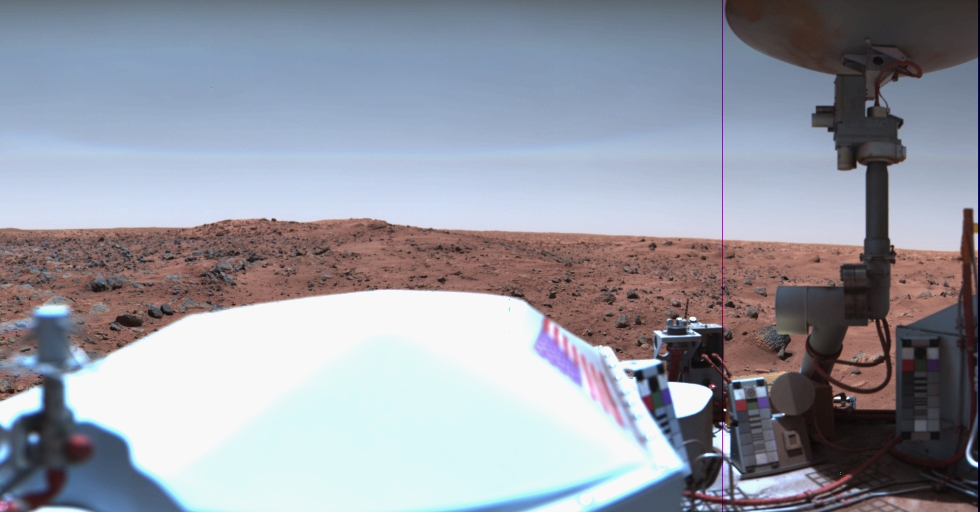Does life on Mars exist?
For many of the people reading the news at this site, I highly doubt that you are sceptical of alien life, however, we’ve still not had any official confirmation that life exists elsewhere in the Solar system or beyond. So let’s review some of the evidence that there might be or been life on Mars in sometime in its past or present.
The first mission to the red planet to determine if alien life existed on Mars was back in 1976 with the Viking spacecraft. Although not the first to the red planet it was the first to successfully land on Mars and take photographs of the surface. Viking was a pair of spacecraft sent to Mars and both beamed back photographic information and science data from different locations.

They were fitted with a number of different instruments for a wide variety of experiments, not least including an onboard mass spectrometer. However, according to NASA scientists, no evidence was found that would indicate that life existed or had existed on Mars. They’ve pretty much stuck to this narrative ever since.
This was the start of the secrecy of Mars, all these billion dollar missions to the red planet, some supposedly looking for life, yet all return supposedly emptyhanded. Or did they?
Reviewing Old Data
Some scientists just weren’t happy with the outcome of the Viking data, and subsequently decided to review the past data from the mission. To their surprise, they’ve found extra data which is difficult to explain without the possibility of life being considered. Challenging the original analysis and certainly, raises more questions.
“Even if one is not convinced that the Viking results give strong evidence for life on Mars, this paper clearly shows that the possibility must be considered. We cannot rule out the biological explanation,” – Chris McKay – NASA Astrobiologist.
Blue skies of Mars
Clearly, something is up and new reviews of past data are starting to show that, maybe, just maybe the original analysis was faulty, or a cover-up was put in place. For a start, it’s been suggested that the actual colour of the sky is blue, like earth.
Check this photo out showing the spacecraft with colour test charts, showing what could be the correct colours and a blue sky! This site has some more information and comparisons with 50% blue and 25% green corrections. This site has some more information on the different colours. It makes you wonder if Mars is indeed more like arid Earth then the possibilities of life and living there increase. Is this a coverup or just a conspiracy theory, that’s something you can decide the debate has been going on for decades.
Missing Opportunities
Here the Telegraph is reporting that back in 2007 it looks as if Spirit rover may have discovered past microbial life showing within the sediment.
As you can see from this picture Mars on the left, Earth on the right, the similarities are pretty distinct, it’s a shame that more study wasn’t conducted on these.
“We went to El Tatio looking for comparisons with the feature found by Spirit at Home Plate,” said Dr Steve Ruff, of the school of Earth and Space Exploration at Arizona.
“Our results show the conditions at El Tatio produce silica deposits with characteristics that are most Mars-like of any silica deposits on Earth.
“The fact that microbes play a role in producing the distinctive silica structures at El Tatio raises the possibility that the Martian silica structures formed in a comparable manner – in other words with the help of organisms that were alive at the time.”
– Scientists from the University of Arizona
Crash Landings
Recently the ExoMars mission by the ESA and Roscosmos attempted to land the Schiaparelli EDM lander on the Marian surface. Unfortunately, the descent didn’t go according to plan and it smashed into the side of Mars. The Schiaparelli EDM lander wasn’t a rover, it was a robotic scientific vessel that was to perform experiments on the local terrain. It was actually a demonstration module for the Entry, Descent and Landing systems of future ExoMars missions for 2020.
The parachute deployed normally at an altitude of 12 km and a speed of 1730 km/h. The vehicle’s heatshield, having served its purpose, was released at an altitude of 7.8 km.
As Schiaparelli descended under its parachute, its radar Doppler altimeter functioned correctly and the measurements were included in the guidance, navigation and control system. However, saturation – maximum measurement – of the Inertial Measurement Unit (IMU) had occurred shortly after the parachute deployment. The IMU measures the rotation rates of the vehicle. Its output was generally as predicted except for this event, which persisted for about one second – longer than would be expected.
When merged into the navigation system, the erroneous information generated an estimated altitude that was negative – that is, below ground level. This in turn successively triggered a premature release of the parachute and the backshell, a brief firing of the braking thrusters and finally activation of the on-ground systems as if Schiaparelli had already landed. In reality, the vehicle was still at an altitude of around 3.7 km.
This behaviour has been clearly reproduced in computer simulations of the control system’s response to the erroneous information.
– esa.int
This lander wasn’t just for testing landing systems it also had a limited but focused science payload that would have measured atmospheric electricity on Mars and local meteorological conditions. As the ESA team are looking send humans to Mars by 2030 as part of Aurora program. The following ExoMars 2020 program is going to be a rover designed to look for life.
Liquid water exists on Mars
For a long time now scientist around the world conjectured that water in any state exists on the Maritain surface. Recently it’s been found and confirmed by NASA that liquid water is running on Mars in places.
These dark, narrow, 100 meter-long streaks called recurring slope lineae flowing downhill on Mars are inferred to have been formed by contemporary flowing water. Recently, planetary scientists detected hydrated salts on these slopes at Hale crater, corroborating their original hypothesis that the streaks are indeed formed by liquid water. The blue color seen upslope of the dark streaks are thought not to be related to their formation, but instead are from the presence of the mineral pyroxene. The image is produced by draping an orthorectified (Infrared-Red-Blue/Green(IRB)) false color image (ESP_030570_1440) on a Digital Terrain Model (DTM) of the same site produced by High Resolution Imaging Science Experiment (University of Arizona). Vertical exaggeration is 1.5.Credits: NASA/JPL/University of Arizona
Finally having confirmation that liquid water is present on the Martian surface today, is a very good sign that life may, in fact, be found existing on or just under the surface. Where liquid water has been found on earth, life has always been found, even in some of the most inhospitable places imaginable.
Look at this picture below, it’s hard to imagine knowing this is caused by present-day liquid water that life doesn’t exist on Mars in one form or another. Personally, I am hoping that more disclosure will free the real untampered evidence on Mars, it’s history and ours along with it.






